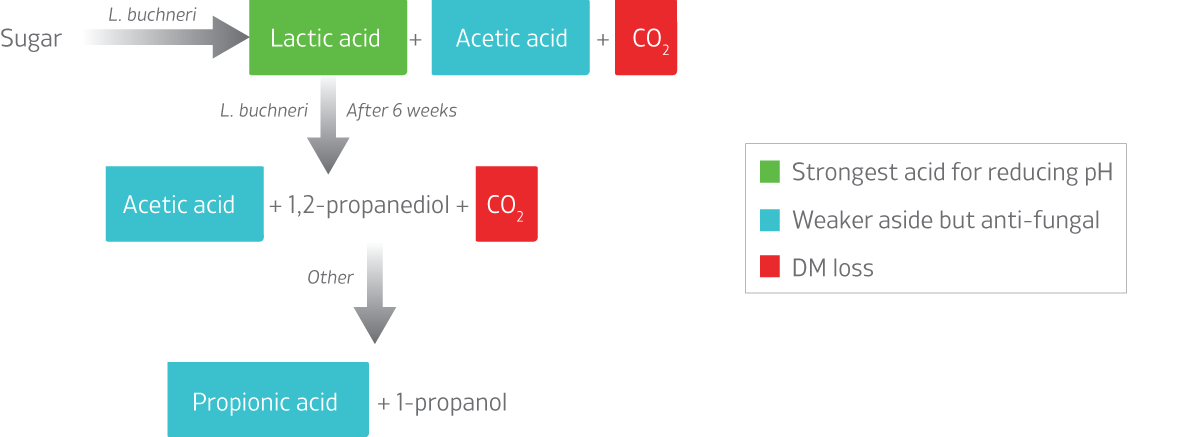We have put together many of the frequently asked questions, but please contact us if there's something we haven't covered.
Silage Advice
-
How important is bunker/pile management at feedout?
Having produced a well fermented, high quality silage, it is vital that the feed out procedure are managed effectively because high losses and reduced animal performance may result from aerobic spoilage. Unfortunately, the best preserved silages are the most susceptible to aerobic spoilage because several of the products of a poor fermentation (acetic acid, butyric acid, ammonia) are inhibitory to the yeasts that initiate spoilage.
Tips for management at feedout
- Have as narrow a face as possible
- Avoid overhangs
- Keep the plastic off the open face
- Keep the face straight with use of a defacer or rake
- Clean up fallen silage regularly
- Discard moldy silage
- Move across the entire face daily
-
What is aerobic spoilage?
This is often wrongly referred to as secondary fermentation but it is not part of the fermentation process as it only occurs in the presence of air and fermentation, by definition, occurs only in the absence of air. It is initiated mainly by yeasts that can grow using a variety of different substances particularly residual sugars and lactic acid. They convert these to carbon dioxide and water and, in the process producing a significant amount of heat and high DM losses. After the initial yeast activity, molds join in. They are able to grow on a wider range of substances so spoilage accelerates. Such silages will also have reduced palatability.

What are the major influences on aerobic spoilage?
- Exposure to air (most important)
– crop DM
– speed of filling
– compaction
– effective sealing
– feedout rate and technique - Fermentation
- Ambient temperature
What types of silage are most susceptible to aerobic spoilage?
- High dry matter silages
- Silages with high residual sugars
- Silages fed in warm weather
- Aerated silages, eg mixed in TMR or transferred or transported forages
How can I minimize aerobic spoilage?
- Narrow feeding face
- Shorter chopping for high DM silages to ensure good compaction
- Good compaction to minimize trapped air
- Good sealing and weighting of covers
- Ensure no damage to cover or bale wrap
- Fast feedout (6 inches/d winter; 1 foot/d summer)
- Twice daily feeding in hot weather
- Keep feeding face straight and tight (defacers)
- Use an effective additive
- Exposure to air (most important)
-
How does Lactobacillus buchneri reduce aerobic spoilage?
This is a species of heterofermentative lactic acid bacteria. During the initial fermentation it competes with homofermentative lactic acid bacteria and converts sugars to a mixture of end products, including acetic acid, something which will reduce the rate of pH fall as well as increase fermentation dry matter losses, neither of which are desirable. But this unusual species can also convert lactic acid into acetic acid and 1,2-propanediol. This results in a silage with a significantly higher acetic acid level than normal and, as acetic acid is inhibitory to the yeasts and molds that cause aerobic spoilage, it is less likely to heat and go moldy at feedout. These activities will increase fermentation DM losses but the potential savings in reduced aerobic DM losses should more than make up for this.
Although 1,2-propanediol is not an acid and has no anti-fungal properties, there are bacteria on forages that can convert it to a mixture of propionic acid and 1-propanol. Propionic acid is an even better anti-fungal agent that acetic acid.

-
How important is it to cover the bunker/pile?
The silo must be sealed as quickly as possible to minimize the time exposed to air initially and allow the fermentation to get started quickly. Line the walls, leaving enough over to allow a 6 foot overlap with the top sheet. Place a second sheet over the top.
Despite being much thinner, oxygen barrier(OB) films have been shown to be more effective than conventional covers. It also ‘sucks’ down onto the surface of the silage, giving a better seal. It should be used to line the walls and cover the top but as it is UV sensitive a conventional sheet (or reusable tarp) will need to be placed on top.
Check the cover periodically for holes and seal with suitable tape. Air infiltration during storage as a result of poor compaction and sealing can increase DM losses by as much as 8%.

-
Do I need an additive with baleage?
With baled silage, fermentation is slower and restricted due to the longer chop length and the higher DM of the crop. There can also be a lot of variability between individual bales, especially if the stand varies across the field; in bunker/piles such variability gets evened out to a large extent.
Bales are also more susceptible to aerobic spoilage due to their high DM and large surface area to volume ratio – 27% of the volume of a 4 foot bale is in the outer 5 cm. They are also less dense compared to packed silage, although improvements in balers have meant densities have been much increased over the years.
Another issue with bales is their susceptibility to growth of Listeria bacteria due to their higher pH and increased risk of aerobic spoilage. Listeria only need a small amount of air infiltration, eg from pierced wrap, to be able to grow.
They can benefit greatly from application of an additive that will make the fermentation faster and more efficient as well as reduce the risk of aerobic spoilage.
-
How many layers of wrap should I apply?
More layers reduces oxygen permeability and the risk of damage to the wrap. A minimum of 4 layers (50% overlap) is essential but increasing to 6 is beneficial as it provides a better oxygen barrier. Some work at CEDAR with black wrap found that 10% DM losses with 4 layers were reduced to just 1% by using 6 layers; the silage also had a better feed value. You should also use more layers with more mature or stalky forages, and very high DM grass, eg haylage, as well as with square bales.
Min. layers Round<40% DM 4 Round 40 - 50% DM 6 Square <50% DM 6 >50% DM or stalky 8